A4.1 Structural safety
Structural failure in houses can be life threatening or cause severe physical injury. Care needs to be taken at the design stage to ensure structural components are suited to the environment and adequate for loads. Common areas of structural failure include:
- Movement in foundations causing major cracking, due to lack of site information about soils and/or poor design
- use of untreated timber, resulting in termite attack
- damage to timber or steel framing caused by leaking wet areas
- failure of steel structures, particularly light-weight frames, through corrosion caused by salt spray.
These problems can be avoided by using a qualified inspector during construction to ensure that the structure is built according to its design and specification.
Structural repairs related to life threatening situations must be considered a higher priority requiring urgent work, for example:
- rotten floors in high set houses, especially in wet areas where there is a water leak or no floor drain, allowing water to penetrate the floor and walls and rot the framing supports
- unstable water tank stands
- rotten or rusted stairs
- corrosion of posts at ground level
- walls with large cracks or dangerously unstable or leaning walls
- piers, stumps and footings being eroded by stormwater
- buildings that are unsafe because of fire damage or severe termite attack
- loose materials such as roof sheeting or windows.
A highly under-rated cause of structural failure is from leaking wet areas within the house (shower, bath, basin, toilet, laundry and behind kitchen sinks). Left to leak continuously over many years, leaking water can rust and rot framed wall and floor structures and cause damage and collapse. Leaks can be caused by:
- not being waterproofed adequately
- leaking of plumbing pipes and fittings
- poor sealing of appliances and fittings to walls.
Survey data show that all the building components that often indicate more serious structural problems have significantly improved since 2013. Reduction in termites by 11%, and more houses had internal walls, external walls and floors in good condition and all these building components showed a 7-10% reduction in the ‘poor’ category.
Real world examples of problems
-
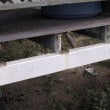 Marine environments can corrode structural steel elements
Marine environments can corrode structural steel elements -
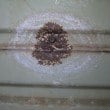 Corroded wall fixings caused by incompatible metals and a salty marine environment
Corroded wall fixings caused by incompatible metals and a salty marine environment -
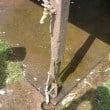 Poorly considered position of tap has rotted a supporting column
Poorly considered position of tap has rotted a supporting column -
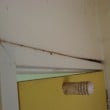 Door inoperable due to wall movement
Door inoperable due to wall movement -
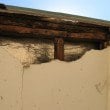 Structural damage from termite attack
Structural damage from termite attack -
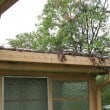 Debris in guttering can lead to rainwater regularly entering the building and damaging the structure.
Debris in guttering can lead to rainwater regularly entering the building and damaging the structure. -
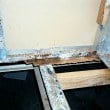 Particleboard flooring in wet areas will rot if it becomes wet
Particleboard flooring in wet areas will rot if it becomes wet -
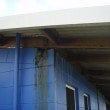 Corroded roof sheeting allows water to effect structural elements
Corroded roof sheeting allows water to effect structural elements
-
Design and Specification
Ensure
- A4.1.1.
structural components of the house are engineered to suit soil and climate conditions.
- A4.1.2.
the local wind conditions have been checked, particularly in coastal cyclonic areas, and inland and desert areas subject to strong winds
- A4.1.3.
if using timber, that termite-resistant timbers and physical termite barriers are used throughout the construction
- A4.1.4.
if using steel, that steel framing, structural components, stairs and hand rails are rust-proofed with an approved system
- A4.1.5.
doming of concrete footings at ground level to reduce water, air and salts causing corrosion of posts at ground level"
- A4.1.6.
only compatible materials are combined- for example, corrosion will occur around wall metal fixings when fixing an incompatible metal sheeting"
- A4.1.7.
bottom plates of wall frames are detailed to avoid rot or rust, especially in wet areas
- A4.1.8.
the height of the floor above ground, particularly when a framed structure is used, is sufficient (no less than 600mm) for regular inspections of the sub-floor areas for termites and water leaks
- A4.1.9.
kitchens and wet areas are detailed and specified to prevent water penetrating the walls or floors
- A4.1.10.
plumbing is designed to suit the local water quality and to reduce leaks and associated structural failure.
- A4.1.11.
Areas beneath houses are dry and well ventilated to prevent conditions that encourage termites
Consider
- In areas of high termite activity using little or no structural timber in the house
- A4.1.1.
Quality control
- footings, foundations, structural tie-downs and other engineering requirements are constructed according to plans and specifications

- COMPLETED DESIGN & SPECIFICATION
DURING CONSTRUCTION
AT HANDOVER
FINAL COMPLETION
- COMPLETED DESIGN & SPECIFICATION
- an engineer or an experienced inspector has inspected the site preparation and provided an inspection report

- COMPLETED DESIGN & SPECIFICATION
DURING CONSTRUCTION
AT HANDOVER
- COMPLETED DESIGN & SPECIFICATION
- termite barriers are installed, are continuous and are undamaged

- DURING CONSTRUCTION
AT HANDOVER
FINAL COMPLETION
- DURING CONSTRUCTION
- all wet areas and kitchen areas are sealed

- DURING CONSTRUCTION
AT HANDOVER
FINAL COMPLETION
- DURING CONSTRUCTION
- the builder has provided warranties for the installation of waterproofing, termite barriers, glass and other proprietary systems.

- AT HANDOVER
FINAL COMPLETION
TRADE TEST
- AT HANDOVER
- an engineer’s certificate is provided for all structural components including footings, slabs, floor framing, wall framing and roof framing with reference to the wind terrain category and soil classification

- COMPLETED DESIGN & SPECIFICATION
AT HANDOVER
- COMPLETED DESIGN & SPECIFICATION
- the site investigation report is provided and corresponds to the information in the engineer’s

- COMPLETED DESIGN & SPECIFICATION
AT HANDOVER
- COMPLETED DESIGN & SPECIFICATION
- footings, foundations, structural tie-downs and other engineering requirements are constructed according to plans and specifications
Maintenance
As part of cyclical maintenance:
- check regularly for rust, rot, termites and other signs of structural deterioration

- Local Maintenance Team
- 12 Months
- fix water leaks including down pipes and sub-surface stormwater pipes to reduce water damage and mosit ground that encourages termites

- Plumber, Local Maintenance Team
- 6 Months
- check garden beds, timber floors and ramps for termites

- Local Maintenance Team, Pest Controller
- 12 Months
- if garden beds have been planted against walls, talk to residents about removing them to make it easier to check for termites

- Local Maintenance Team
- 12 Months
- consider organising a regular program of termite inspections and treatments by a qualified pest controller

- Pest Controller, Housing Management
- 12 Months
- in tropical areas or areas close to the coast, check for corrosion of steelwork and re-apply paints and other protective coatings.

- Local Maintenance Team
- 12 Months
- inspect, tighten, replace or install structural tie-downs between roof, wall and floor

- Local Maintenance Team, Engineer
- 24 Months
- if the roof is nailed on, replace the nails with screws and cyclone washers and have a qualified engineer check that the structure of the roof is in good condition before replacing the roof sheeting.

- Carpenter, Engineer, Housing Management
- 24 Months
- if upgrading or repairing a house with severe structural failures, the residents should be relocated to another house and a qualified engineer should be consulted.

- Housing Management
- 24 Months
- talk with tenants about removing any piles of wood or loose timber stacked beneath or up against the walls of houses that might attract termites

- Housing Management
- 24 Months
- check regularly for rust, rot, termites and other signs of structural deterioration
Standard And References
AS 2870-2011- Residential slabs and footings
AS 2312.1:2014 and AS/NZS 2312.2:2014 - Guide to the protection of structural steel against atmospheric corrosion by the use of protective coatings - this is in two parts: Paint coatings and Hot dip galvanizing.
